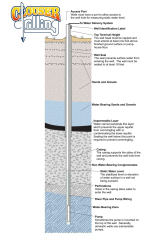MossRoad
Super Moderator
- Joined
- Aug 31, 2001
- Messages
- 65,523
- Location
- South Bend, Indiana (near)
- Tractor
- Power Trac PT425 2001 Model Year
Ive scoured the internet and cant find a direct answers.
Went back out to the property yesterday and measured my neighbors ( vacant property ) abandoned well. The well casing ( steel ) is just covered by a pot.
62 feet down with a heavy object tied to a string and I am in water which appears to be the water table depth for my area. I understand it rises and falls, last week it was 67 feet but they just recently had quite a bit of rain.
The well is 135 feet deep which means there is a 73 foot water column in that casing.
I do not understand how the water gets in the casing, they are using metal pipe and Im sure that it is not perforated at the bottom few feet so how does it get in the casing? Im guessing that its like placing a straw in a glass of water.....that the water level will rise within the straw thru the bottom of the straw to become even with surrounding water level outside of straw but this casing is not buried in a lake, its buried in water bearing sand and am I to assume that this sand is so saturated with water that it will replenish itself very quickly?
I did not know this and have been wondering for a long time. ( assuming my assumptions are correct )
I do not know why the well was abandoned, there is a second well right near it that is supposedly used maybe once a year just to keep it alive from what I have been told.
Ok and what is the thing just above this well with the bicycle wheel?
Thanks
There's perforation somewhere in the pipe. There has to be or water won't enter it. Maybe this diagram will help.
